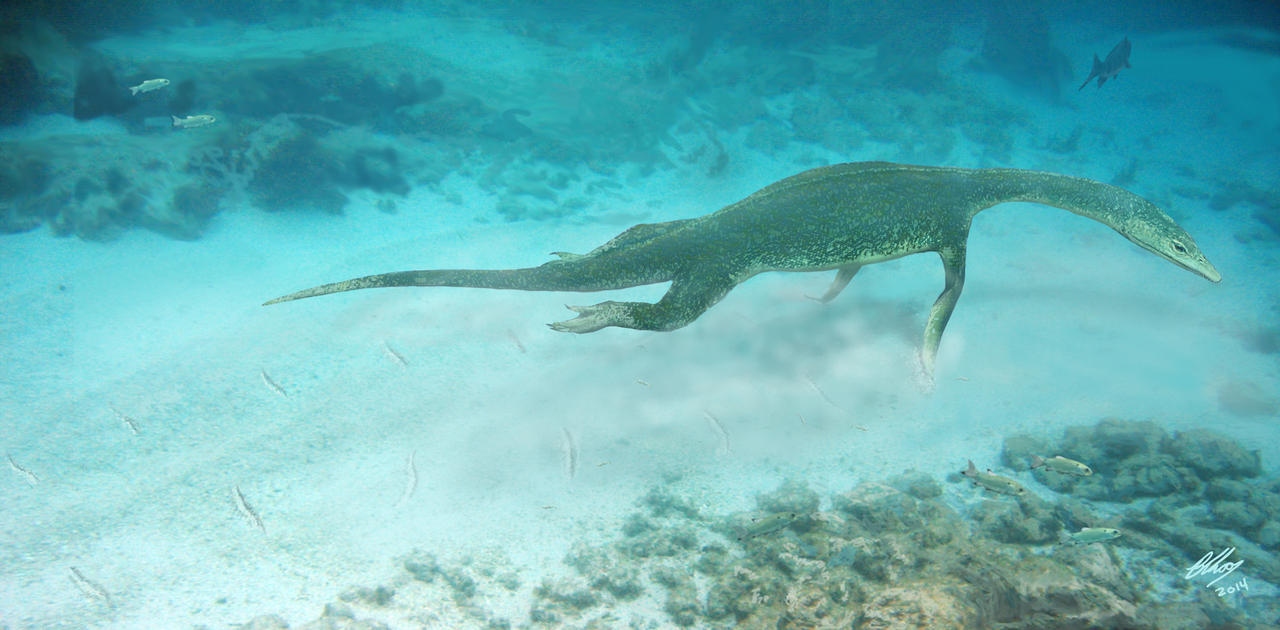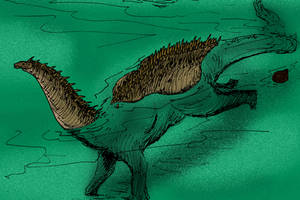ShopDreamUp AI ArtDreamUp
Deviation Actions
Suggested Deviants
Suggested Collections
You Might Like…
Featured in Groups
Description
Triassic Seas of South China #4 = Lariosaurus goes for a stroll
Acrylics, digital and photography, 2014
created for = Qiyue Zhang, Wen Wen, Shixue Hu, Michael J. Benton, Changyong Zhou, Tao Xie, Tao Lü, Jinyuan Huang, Brian Choo, Zhong-Qiang Chen, Jun Liu & Qican Zhang (2014) Nothosaur foraging tracks from the Middle Triassic of southwestern China, Nature Communications 5, Article number: 3973 doi:10.1038/ncomms4973
ca. 245,000,000 bp, Middle Triassic (Anisian), Luoping County, Yunnan, China (Member II of the Guanling Formation)
A small nothosaur (Lariosaurus cf.hongguoenis) forages on a shallow seabed in search of lobsters and small fishes. It propels itself along with rowing motions of it's paddle-like forelimbs, leaving behind distinctive prints on the sediment (ichnotaxon Dikoposichnus luopingensis).
The Luoping Biota of Yunnan (gogosardina.deviantart.com/art…) is already well known for its outstanding body fossils of a Triassic marine community. However, when Qi-yue Zhang, of the Chengdu Center of the China Geological Survey, was mapping geological features near the village of Daaozi, he noticed several track marks on a ledge. The team dug up the area on the ledge and exposed 350 exquisitely preserved prints that formed about 15 different trackways. Each print is a narrow V-shaped slot-like depression with a mound of sediment behind it.
The spacing and contours of these tracks perfectly match the fore-paddles of nothosaurs. They're too big to be made by pachypleurosaurs, lack the distinct clawed-digits of placodonts, saurosphargids and thalattosaurs, while are outside the range of motion possible for ichthyosaurs.
The trackways fall into small (35-42cm outer width) and large (50-67cm) size classes. Complete body fossils of two species of nothosaurs, the small 80cm Lariosaurus hongguoensis and the much bigger (2-4m) Nothosaurus yangjuanensis, are known from the slightly younger Panxian locality, both of which are likely creators of these prints.
The trackways provide the first direct evidence of sauropterygian swimming behaviour. The nothosaurs moved along the seafloor by punting their forelimbs in unison rather than with an alternate back-and-forth motion. This may have implications with reconstructing how other sauropterygians (ie. plesiosaurs) swam.
Acrylics, digital and photography, 2014
created for = Qiyue Zhang, Wen Wen, Shixue Hu, Michael J. Benton, Changyong Zhou, Tao Xie, Tao Lü, Jinyuan Huang, Brian Choo, Zhong-Qiang Chen, Jun Liu & Qican Zhang (2014) Nothosaur foraging tracks from the Middle Triassic of southwestern China, Nature Communications 5, Article number: 3973 doi:10.1038/ncomms4973
ca. 245,000,000 bp, Middle Triassic (Anisian), Luoping County, Yunnan, China (Member II of the Guanling Formation)
A small nothosaur (Lariosaurus cf.hongguoenis) forages on a shallow seabed in search of lobsters and small fishes. It propels itself along with rowing motions of it's paddle-like forelimbs, leaving behind distinctive prints on the sediment (ichnotaxon Dikoposichnus luopingensis).
The Luoping Biota of Yunnan (gogosardina.deviantart.com/art…) is already well known for its outstanding body fossils of a Triassic marine community. However, when Qi-yue Zhang, of the Chengdu Center of the China Geological Survey, was mapping geological features near the village of Daaozi, he noticed several track marks on a ledge. The team dug up the area on the ledge and exposed 350 exquisitely preserved prints that formed about 15 different trackways. Each print is a narrow V-shaped slot-like depression with a mound of sediment behind it.
The spacing and contours of these tracks perfectly match the fore-paddles of nothosaurs. They're too big to be made by pachypleurosaurs, lack the distinct clawed-digits of placodonts, saurosphargids and thalattosaurs, while are outside the range of motion possible for ichthyosaurs.
The trackways fall into small (35-42cm outer width) and large (50-67cm) size classes. Complete body fossils of two species of nothosaurs, the small 80cm Lariosaurus hongguoensis and the much bigger (2-4m) Nothosaurus yangjuanensis, are known from the slightly younger Panxian locality, both of which are likely creators of these prints.
The trackways provide the first direct evidence of sauropterygian swimming behaviour. The nothosaurs moved along the seafloor by punting their forelimbs in unison rather than with an alternate back-and-forth motion. This may have implications with reconstructing how other sauropterygians (ie. plesiosaurs) swam.
Image size
3760x1848px 3.34 MB
Make
Canon
Model
Canon PowerShot S50
Shutter Speed
1/807 second
Aperture
F/2.8
Focal Length
7 mm
Date Taken
Jan 3, 2008, 12:34:43 PM
Sensor Size
10mm
© 2014 - 2024 Gogosardina
Comments41
Join the community to add your comment. Already a deviant? Log In
Interesting


































